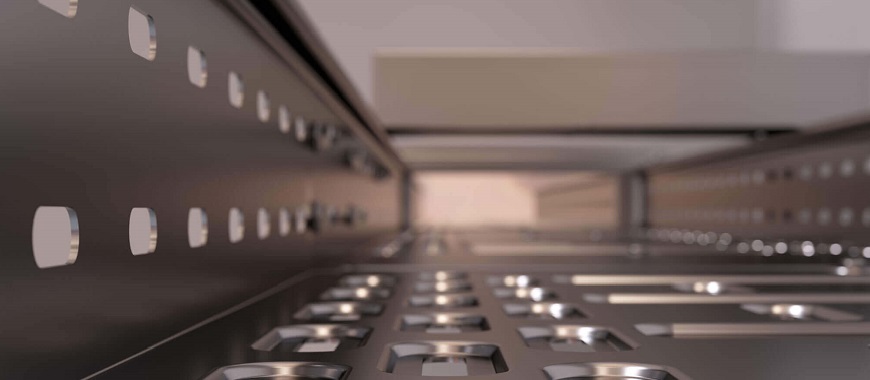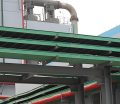
Cable tray drop out is a crucial component in modern cable management systems. It provides a secure and organized solution for routing cables. Designed to prevent cable wear and reduce stress points, it ensures the longevity and reliability of installations. Cable tray drop out is used in a wide range of industries, including commercial, industrial, and data center applications. Its ability to simplify cable routing and improve overall efficiency makes it an essential tool for managing complex wiring setups. By facilitating smooth transitions and reducing cable strain, it minimizes maintenance needs and enhances workplace safety. Understanding its functionality and purpose is vital for selecting the right system to meet specific project demands and industry standards.
How About Cable Tray Drop Out?
Cable tray drop out plays a vital role in managing cable systems effectively. It allows cables to transition smoothly from the tray to equipment, reducing stress and wear. By incorporating cable tray drop out into installations, projects benefit from organized cable routing and enhanced safety. This component is a key element in maintaining structured wiring systems, preventing cable damage, and ensuring longevity in various applications. Whether in industrial facilities, commercial spaces, or data centers, cable tray drop out offers a practical solution for efficient cable management. The integration of cable tray drop out systems simplifies installation, minimizes maintenance, and meets diverse project requirements.
Types of Cable Tray Drop Outs
Metallic Ladder Trays
Metallic ladder trays are a common choice for cable tray drop out systems. These trays provide a robust framework for supporting cables, ensuring stability and ease of access. Their design includes parallel rails connected by rungs, offering excellent ventilation to prevent overheating of cables.
In industrial environments, metallic ladder trays are frequently used due to their strength and durability. They are capable of withstanding heavy cable loads, making them ideal for power plants, factories, and large-scale facilities. Similarly, in commercial settings, metallic ladder trays are utilized for their ability to handle various cable types efficiently while maintaining an organized appearance.
Wire Basket Trays
Wire basket trays are another versatile option for cable tray drop out setups. Their lightweight construction and mesh-like design make them easy to install and adjust as needed. This flexibility is particularly beneficial in projects where frequent changes or expansions to the cable layout are expected.
The benefits of using wire basket trays include improved airflow around cables, which reduces the risk of overheating. Additionally, their open design allows for quick visual inspections and easier maintenance. Wire basket trays are often preferred in data centers and telecommunication facilities, where neat and accessible cable routing is essential.
Box Type Cable Tray: Durable Solutions for Wiring Management
Key Features of Cable Tray Drop Outs
Material Options
Cable tray drop out systems are available in a variety of materials to suit different environments and applications. Steel options provide a cost-effective and sturdy solution for general use, while stainless steel variants, such as 304L and 316L, offer enhanced corrosion resistance.
Durability is a key consideration when selecting material options for cable tray drop out systems. In harsh environments, such as chemical plants or coastal areas, stainless steel ensures long-term performance by resisting rust and other forms of degradation. These materials maintain structural integrity even under challenging conditions, making them a reliable choice for critical installations.
Sizes and Specifications
The flexibility of cable tray drop out systems is reflected in their range of sizes and specifications. Rail heights typically vary from 4 inches to 7 inches, accommodating different cable volumes and load requirements.
Width sizes of up to 36 inches are available, providing ample space for organizing large bundles of cables. These dimensions ensure that installations can be customized to meet the unique needs of each project. Whether for a small-scale operation or a large industrial complex, the right size options contribute to efficient and effective cable management.
Benefits of Cable Tray Drop Outs in Projects
Enhancing Workplace Safety
Cable tray drop out systems improve safety by preventing cable entanglement and reducing trip hazards. Proper routing minimizes the risk of accidents and ensures a secure working environment.
Reducing Cable Wear
By providing a smooth transition for cables, cable tray drop out reduces stress and strain on the wires. This prolongs their lifespan and minimizes the need for frequent replacements.
Facilitating Maintenance
Cable tray drop out systems simplify maintenance tasks by offering easy access to cables. This feature ensures that troubleshooting and repairs can be completed quickly, reducing downtime.
Supporting Versatility
With various material and size options, cable tray drop out systems are adaptable to a wide range of applications. Their flexibility allows them to be used in industrial, commercial, and specialized environments.
Meeting Industry Standards
Cable tray drop out systems are designed to comply with industry regulations, ensuring that installations meet safety and quality requirements. This makes them a reliable choice for professionals.
How to Choose the Right Cable Tray Drop Out
Factors to Consider
Environmental Conditions
The environment where the cable tray drop out system will be installed plays a significant role in determining the type of materials and design required.
- Temperature and Humidity: High temperatures or moisture levels can degrade certain materials over time. In humid environments, opt for systems with protective coatings to prevent rust or corrosion.
- Chemical Exposure: In industrial settings where chemicals are present, materials resistant to chemical corrosion, such as fiberglass-reinforced plastic, should be used.
Cable Type
Different projects may involve varying types of cables, and the tray system should be compatible with these types.
- Power Cables: These are typically heavier and require a drop out system with a high load capacity and secure fittings to prevent damage.
- Data Cables: For sensitive data cables, it is crucial to choose a drop out system with smooth edges and ample space to avoid bending or compression, which can affect performance.
- Hybrid Systems: Some projects require managing both power and data cables. In such cases, a drop out system with separation panels or dedicated channels is ideal to minimize electromagnetic interference.
Load Capacity
The load capacity of the drop out system is another critical factor, as it determines the system’s ability to support the weight of the cables without deformation or failure.
- Cable Density: Assess the number of cables the system will need to accommodate. Overloading a system can lead to sagging or structural damage.
- Future Expansion: Consider the possibility of future additions to the cable system. Choosing a drop out system with a slightly higher load capacity than currently required can save time and costs in the long run.
- Support Spacing: Ensure that the spacing of supports along the tray matches the load capacity of the system. Inadequate support can cause stress on the tray, leading to premature wear.
System Design and Flexibility
The design of the cable tray drop out system should align with the project’s layout and specific needs.
- Ease of Installation: Systems that are easy to install save time and reduce labor costs. Modular designs are particularly useful, allowing for quick assembly and customization.
- Access for Maintenance: The system should provide sufficient access for routine maintenance and troubleshooting. Drop out systems with hinged covers or open designs simplify this process.
- Scalability: A flexible system that allows for modifications and expansions is essential for projects expected to evolve over time.
Safety and Compliance
Safety is paramount in any cable management system. A drop out system must meet relevant safety standards and regulatory requirements.
- Fire Resistance: In environments with a risk of fire, select a system made from fire-resistant materials to prevent cable damage and ensure safety.
- Compliance with Codes: Ensure the system adheres to local and international building codes and industry standards. This guarantees the installation is both safe and legally compliant.
- Load Testing: Verify that the system has been tested for load capacity and structural integrity under realistic conditions.
Cost and Longevity
While cost is an important factor, it should not outweigh the need for quality and durability.
- Initial Investment: Select a system that fits within the project’s budget while still meeting essential criteria.
- Maintenance Costs: A high-quality system may have a higher initial cost but can save money over time through reduced maintenance and replacement needs.
- Durability: Systems made from durable materials may cost more upfront but offer better performance and longevity, particularly in demanding environments.
By carefully evaluating these factors, you can select a cable tray drop out system that not only meets the immediate needs of your project but also provides reliable performance and adaptability for years to come.
Best Practices for Installation
Proper installation is crucial for maximizing the benefits of cable tray drop out systems. Ensure that cables are routed without excessive bends and secure them firmly to the tray.
Cable tray drop out systems are indispensable in creating organized, efficient, and safe cable management solutions. Their versatility, durability, and ease of use make them a valuable asset for any project. Whether you need a robust metallic ladder tray or a flexible wire basket tray, these systems provide the support and functionality required to meet diverse demands. For more details on specific options, explore products like GangLong Fiberglass, which are tailored to meet industry standards and enhance performance in all settings.
Understanding Cable Tray Depth and Its Importance
The Key of Cable Tray Drop Out
Cable tray drop out serves as a vital component in modern wiring systems, enabling smooth and efficient cable transitions. Alongside cable tray drop down solutions, it enhances the organization, safety, and accessibility of cable management setups in various industries. Whether in industrial facilities or data centers, cable tray drop out ensures the longevity of cables by reducing wear and strain. Similarly, cable tray drop down options provide practical support for vertical cable transitions, adding further flexibility to installations. These features simplify maintenance and help meet the unique demands of different applications, making them indispensable parts of structured wiring systems.
Benefits of Cable Tray Drop Outs in Projects
Enhancing Safety and Organization
Cable tray drop out contributes significantly to workplace safety by ensuring proper cable alignment and reducing clutter. When cables are routed correctly, the risks of tangling or damage are minimized, creating a safer environment for workers and equipment.
The design of cable tray dropout ensures easy accessibility to cables. Maintenance teams can identify and address issues quickly, reducing downtime and preventing potential hazards. Organized systems also allow for better airflow, preventing overheating and maintaining operational efficiency.
Customization and Flexibility
Cable tray drop out systems are designed to cater to a variety of applications. The ability to customize sizes, materials, and designs allows for tailored solutions that meet specific project requirements. Whether for heavy-duty industrial operations or smaller commercial installations, cable tray drop out offers unmatched adaptability.
Meeting diverse project needs is a key feature of cable tray drop out. With options for different load capacities, rail heights, and finishes, it ensures compatibility with unique challenges, from harsh environmental conditions to high-density cable setups.
What Is Code for Cable Tray Installation?
How to Choose the Right Cable Tray Drop Out
Factors to Consider
- Choosing the right cable tray drop out involves evaluating material compatibility with the installation environment. For example, stainless steel options are ideal for environments prone to corrosion, while steel variants are suitable for general use.
- Size and weight capacity are critical considerations. Rail heights ranging from 4 inches to 7 inches and width sizes up to 36 inches ensure that the system can accommodate the volume and weight of cables effectively.
Best Practices for Installation
Effective installation of cable tray dropout requires careful planning and adherence to best practices. Routing cables without sharp bends prevents strain, ensuring longevity and optimal performance.
Compliance with industry standards is essential for safety and efficiency. Properly securing cables within the tray system ensures stability during operation and reduces maintenance needs over time.
Cable tray drop out is essential for achieving efficient and organized cable management. It provides a reliable solution for transitioning and securing cables in various applications. Its versatility, safety features, and ability to meet specific project demands make it an invaluable component in modern installations. By exploring options such as GangLong Fiberglass, professionals can ensure that their systems are built to last and deliver exceptional performance in any setting.
FAQs about Cable Tray Drop Out
The life expectancy of a cable tray depends on its material and environment. For standard steel cable trays, the average lifespan ranges from 10 to 15 years in non-corrosive environments. Stainless steel options, such as 304L and 316L, can last significantly longer, often exceeding 25 years, especially in harsh or corrosive conditions. Regular maintenance and inspections can extend the lifespan by identifying and addressing wear or corrosion early. Proper installation and choosing materials that suit the specific environment are crucial for ensuring maximum longevity.
Cable trays are fixed using a combination of brackets, supports, and clamps to secure them in place. These components are typically installed on walls, ceilings, or floors, depending on the project requirements. Support spacing is determined by the tray’s weight capacity and load distribution. Cables are then fastened to the tray using ties or straps to ensure stability. Proper alignment during installation minimizes strain and enhances the overall performance of the cable tray system.
Yes, cable trays should remain accessible to facilitate maintenance, inspection, and cable modifications. Accessibility ensures that repairs or upgrades can be performed without disrupting operations. Maintaining clear access to the tray system also allows for proper airflow, reducing the risk of overheating. During installation, ensure there are no obstacles that could impede future access. This accessibility is essential for ensuring long-term functionality and compliance with safety standards.
Cable tray trunking is a system used for routing and protecting cables within enclosed or partially enclosed channels. Unlike open cable trays, trunking provides additional protection against dust, debris, and physical damage. It is commonly used in environments where cables require added security, such as in industrial facilities or areas exposed to contaminants. Cable tray trunking also helps in organizing cables neatly, reducing clutter and ensuring a professional appearance. It is available in various materials and sizes to suit different applications.

As the editor of GangLong Fiberglass, I have years of experience and in-depth research, focusing on cable tray products, fiberglass solutions, and grille systems. I incorporate years of industry insights and practical experience into every content, committed to promoting the progress of the industry. At GangLong Fiberglass, my commitment is reflected in every product, from innovative cable trays to durable fiberglass solutions and sturdy grille systems. As an authoritative voice in the industry, my goal is to provide valuable information to professionals and businesses and promote forward-looking solutions.


